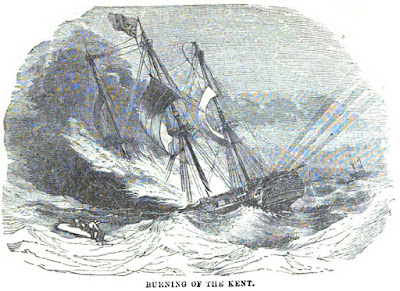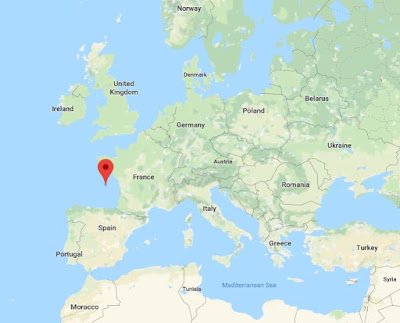The fire reached the powder magazine and the looked-for explosion took place. The burning fragments of the vessel were blown high into the air, like so many rockets.
 |
| This story is an excerpt from Thrilling Adventures at Sea or Noted Shipwrecks and Famous Sailors, published by Crawford & Company 1885 |
Burning of the Kent
Whilst on her outward passage, the Kent East Indiaman was burnt, on the 28th of February, 1825, in the Bay of Biscay. She had on board in all six hundred and forty-one persons. An officer on duty during a storm, finding that a spirit-cask in the hold had broken loose, was taking measures to secure it, when a lurch of the ship caused him to drop his lantern, and in his eagerness to save it, he let go the cask, which suddenly stove in, the spirits communicated with the flame, and the whole place was instantly in a blaze. Hopes of subduing the fire at first were strong, but soon heavy volumes of smoke, and a pitchy smell, told that it had reached the cable-room.
 |
| Bay of Biscay |
In these awful circumstances, the captain ordered the lower decks to be scuttled, to admit water; this was done: several poor seamen being suffocated by the smoke in executing the order; but now a new danger threatened, the sea rushed in so furiously, that the ship was becoming water-logged, and all feared her going down. Betwixt six and seven hundred human beings were by this time crowded on the deck. Many on their knees earnestly implored the mercy of an all-powerful God, while some old stout-hearted sailors quietly seated themselves directly over the powder magazine—expecting an explosion every moment, and thinking thus to put a speedier end to their torture.
In this time of despair, it occurred to the fourth' mate to send a man to the foremast, hoping, but scarce daring to think it probable, that some friendly sail might be in sight. The man at the foretop looked around him; it was a moment of intense anxiety; then waving his hat he cried out, "A sail on the lee bow!"
Those on deck received the news with heart-felt gratitude, and answered with three cheers. Signals of distress were instantly hoisted, and endeavors used to make toward the stranger, while the minute-guns were fired continuously. She proved to be the brig Cambria, Captain Cook, master, bound to Vera Cruz, having twenty Cornish miners, and some agents of the mining company on-board. For about a quarter of an hour, the crew of the Kent doubted whether the brig perceived their signals; but after a period of dreadful suspense, they saw the British colors hoisted, and the brig making toward them.
On this, the crew of the Kent got their boats in readiness the first was filled with women, passengers, and officers' wives, and was lowered into a sea so tempestuous as to leave small hope of their reaching the brig; they did, however, after being nearly swamped through some entanglement of the ropes, getting clear of the Kent, and were safely taken on board the Cambria, which prudently lay at some distance off.
After the first trip, it was found impossible for the boats to come close alongside of the Kent, and the poor women and children suffered dreadfully, in being lowered over the stern into them by means of ropes. Amid this gloomy scene, many beautiful examples occurred of filial and parental affection, and of disinterested friendship; and many sorrowful instances of individual loss and suffering. At length, when all had been removed from the burning vessel, but a few, who were so overcome by fear as to refuse to make the attempt to reach the brig, the captain quitted his ill-fated ship.
The flames, which had spread along her upper deck, now mounted rapidly to the mast and rigging, forming one general conflagration, and lighting up the heavens to an immense distance around. One by one her stately masts fell over her sides. By half-past one in the morning the fire reached the powder magazine; the looked-for explosion took place, and the burning fragments of the vessel were blown high into the air, like so many rockets.
 |
| Coat of arms of the East India Company circa 1700 |
The Cambria, with her crowd of sufferers, made all speed to the nearest port, and reached Portsmouth in safety, shortly after midnight, on the 3rd of March. Wonderful to tell, fourteen of the poor creatures left on the Kent were rescued by another ship, the Caroline, on her passage from Alexandria to Liverpool.


Comments
Post a Comment